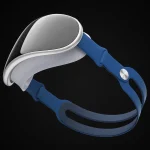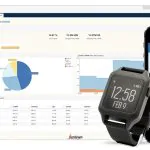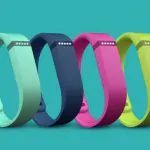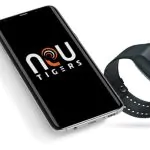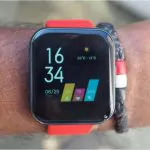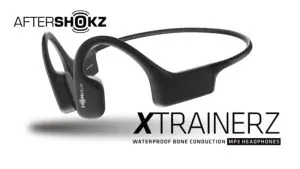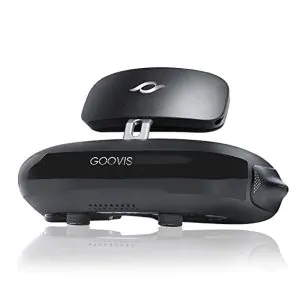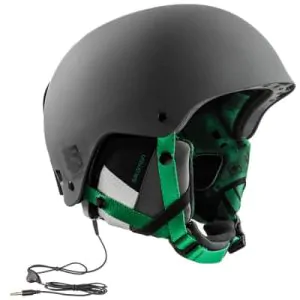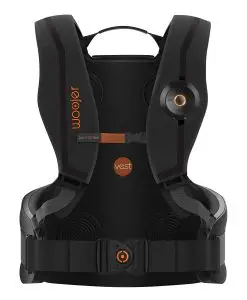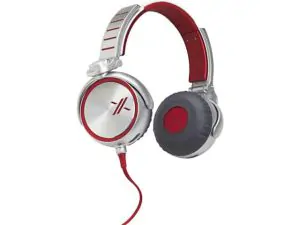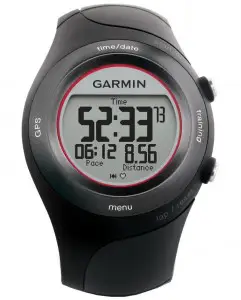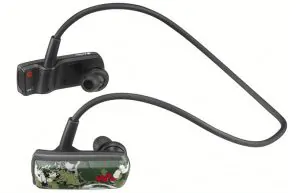Amazon’s recent incursion into wearables continues with its Halo fitness tracker – which has made it out of beta and is available in the US for $99.99.
In more than a decade of reviewing gadgets, I’ve never been as reluctant to test a product than the Amazon Halo.
Wearables, by their very nature, are more personal than any type of tech in history. But the upshot has been actionable insights that have enabled people to enjoy better lifestyle and fitness choices.
Can it stand out in a crowded field thanks to tone of voice analysis and body scanning? And at what cost to privacy and intimacy?
Amazon Halo review: Design and specs
The Amazon Halo looks and feels like a low budget Whoop Strap 3.0. And the similarities weren’t lost on Whoop. It claims Halo “imitates” the design and CEO Will Ahmed also noted Whoop met with Amazon regarding potential investment from the Alexa fund.
All that aside, the Halo is a light (18g) and slim fitness tracker with the Velcro fabric strap covering the plastic sensor. It has no display, which will be fine for those seeking fewer distractions.
There’s just a single button for interaction with the Halo app, a pair of microphones for picking up your utterances and an LED indicator light. It’s comfortable to wear even when sweaty.

Whoop (left), Help (right)
To that end, there are loads of options for replacement bands offering different colours and materials.
Despite the on-board microphones there’s no sign of Alexa integration.
The sensor is rated at 5ATM, which means swim tracking and waterproofing to 50 metres, which is a definite bonus. Smartphone connection is enabled by Bluetooth 5.0.
Amazon Halo review: Tone of voice
Arguably the most controversial feature is Tone analysis, which uses the microphones to monitor your speech.
Utterances are measured against a baseline of normal speech (established by reading Dickens et al during set-up) and informs how you sounded during the day based on high/low positivity and energy.
The idea is to give people insight into how they are being perceived. Are you a high-energy, positive person? Or are you putting negativity out there? How is this affecting your relationships at work and at home?
Does your low-energy speech denote tiredness or need for self-care? Are there changes you can make by identifying these trends and being more mindful in future?

Throughout the day, you’ll see in-app cards that inform you when the band has detected variances in tone based on positivity and energy. If you sounded friendly, sad, restrained, frustrated, hesitant, and so on, you’ll see the time and other emotions detected.
This can be helpful, if you can connect the dots. One Sunday night I had a heated conversation where I sounded “Stubborn” for 2.3 seconds. “You had one phrase that sounded stubborn, aggressive or condescending,” the app told us.
I was watching football the other day and Halo said I sounded “disgusted”. I was watching Manchester United lose, so it was bang-on.
It also has me marked as Jekyll & Hyde. At one point, I was apparently delighted and annoyed within the same minute.
However, this left me wanting to dive deeper. What exactly had I said here? But Halo isn’t monitoring what you say, just how you say it. Where’s Alexa to record everything when you need it?
Halo generally identified about 5-6 very brief phrases each day. There are times I’d expected to see lots of activity, but didn’t. If you want this feature to be more active, you can switch to More Tone in the settings, but that scythes battery life in half.
There is a useful Live tab offering real-time analysis. You can use this to practice or record a conversation for an analysis of how you came across.
It’s incredibly interesting to watch. With each word, you’ll see your voice move around the positivity and energy graph, complete with analysis of how you’re sounding.
I told the dog what a good boy he was, and the indicator jumped to the top of ‘Positivity and High Energy’ axis and I was deemed to be happy, delighted and appreciative.
This feature could be interesting if you’re practicing public speaking, or rehearsing for a job interview, for example.
Amazon Halo review: Body Fat

The Halo app offers a body scanning tool, which creates a 3D model based on head-to-ankle photographs from four angles. The wristband itself is uninvolved.
For someone carrying lockdown timber and still avoiding gyms and yoga studios, this was humbling.
Amazon says its readings are twice as accurate than the top smart scales. I use a Eufy model with body composition data. I’m not revealing my body fat percentage (or the scans) but the Halo had my body fat percentage 5% higher than Eufy. That’s a pretty big divergence.
The app tracks progress over time, enabling you to browse previous scans for signs of visual change. If you’re a person who takes mirror photos for the before/after social media post, you’ll probably enjoy this.
When Halo was announced, this feature that spawned half-serious “Amazon wants your nudes” headlines. Indeed, you do have to strip down to your smalls to capture the imagery.
Amazon says the images required to create the scans are processed in the cloud and then deleted. Photos and scans remain on your phone only. I upgraded my phone half-way through the review. The data remained, but the images were gone, so all good.
Do you completely trust Amazon though? Ultimately that determines whether you’ll Halo a shot. And ultimately, given so many of us already have Alexa smart speakers, where do you draw the line? For many, near naked photos is the line.
Amazon Halo review: Activity Tracking

Back to more run-of-the-mill wearable features, Amazon Halo is a capable activity tracker.
Halo continuously tracks heart rate through an optical sensor and movement through an accelerator and gyroscope. Those two factors are combined to denote how active you’ve been. Pretty standard.
Amazon takes a slightly different approach with collating activity. You get two points per minute of intense activity (70%+ of max heart rate), 1ppm for moderate (50% to 70% max HR), and 1 point per 20 minutes of light activity (grocery shopping, for example). You lose a point for every hour you’re sedentary beyond eight.
Amazon says at least 150 points a week matches WHO physical activity guidelines. If you top 300 points, you’re classed as very active.
In one week, I ran a 5k, cycled at full pelt for an hour, took a 30-minute TRX workout, played a ton of darts and walked the dog every night. That got me 349 points.
It’s a good system – but only for those struggling to get active. The difference in strain and calorie burn when you’re at 90% of your max HR and 70% is huge, for example, yet it carries the same points reward in this system.
The Halo also counts steps and calories and will automatically auto track exercise like walking and running, which can also be manually added.
There’s also no built-in GPS and Halo doesn’t attempt to piggyback on the smartphone connection. It also doesn’t offer an estimated distance based on the step count.
Amazon Halo: Heart rate tracking

Data from the wrist-based optical sensor was closer than I’d imagined to my chest-worn Polar H10 – a gold standard for a consumer product.
During a 30:01-minute 5K run, Halo registered my heart rate peak at 179bpm, averaging 164bpm. Polar registered a 181bpm max, averaging 168bpm. The Halo estimated a calorie burn of 507 compared to 581 from the Polar. So the data is well within a good range of accuracy.
On an hour-long cycle, the Polar recorded a max HR of 180bpm, compared to the Halo’s 173bpm. This disparity isn’t uncommon even when comparing high-end wrist-based sensors with the chest-worn options, so the Halo actually performed a little better than expected here.
You can check in to see the Live tab to view real-time HR and occasionally you’ll get insights about your resting heart rate being higher or lower during a particular week and what that may signify.
Amazon Halo review: Sleep tracking

Sleep tracking calculates time asleep, time awake and time to fall asleep. It’ll also break down time spent in the various sleep stages (REM, Light, Deep). These metrics, plus the number of disturbances, contribute to an overall sleep score.
Again, Amazon has a points system, with a score of 85-100 counted as a great night’s sleep and 0-49 considered poor.
Resting heart rate doesn’t appear to be a consideration and heart rate variability isn’t measured at all. The scores can be a useful guide, but it doesn’t offer the holistic picture some more advanced devices do – such as the Fitbit Inspire 2 or Charge 4.
There is a sleep temperature measurement too, which is interesting. I found my body temp rose by 0.7% on a night I’d had a few alcoholic drinks and dropped slightly below the baseline when I hadn’t. Interesting information to making sense of lifestyle changes.
The Halo app does offer plenty of sleep tips. If you have low sleep efficiency (time in bed vs time sleep), for example, with ideas on how to improve. It may also suggest also deploy a ‘Lab’ from Headspace from within the Halo app, for activities to try as part of your bedtime routine. More on that shortly.
Compared with the lookalike Whoop Strap 3.0, which is well-renowned for its sleep tracking capabilities, Halo compared pretty well overall.
Amazon Halo review: Labs

A major Halo perk is the content from reputable companies in the wellness space, included in the membership price.
Noted fitness partners like Orangetheory, Sweat, 8fit and Aaptiv provide video-led workouts and training plans. Lifesum, Headspace and Weight Watchers et al offer general wellness tips for mind and body.
Users are encouraged to engage in these science-backed Labs as a single activity or days/weeks-long programs. Positive changes will be picked up by the wristband and further explained within the app.
For example, by partaking in the “sleep sounds” program from Headspace, I noted my sleep efficiency score went up because I was falling asleep faster. Amazon notes that other potential benefits include more time in deep sleep and a reduced number of disturbances.
Some labs are auto-tracked, like Lunchtime Powerwalks from the American Heart Association, while others, like the 150-Minute Fix from Orangetheory will guide you through four workouts 30-minute-plus workouts in a week.
The symbiotic relationships between these Labs and the potential areas of improvement detected by Halo is a definite hit and Amazon could really be onto something with this element of the proposition.
Amazon Halo review: Battery life and charging

The Amazon Halo has a battery life of around 7 days if you’re only using it as a fitness tracker with continued heart rate monitoring. However, with Tone analysis enabled, you’ll need to charge every other day. We’ve been getting around 46 hours of usage between charges.
The Halo has a proprietary charging solution. Yay! Another to add to your collection. It’s a cumbersome and unnecessarily large clip and it’s finicky too. It takes a little finagling to create a connection with the charging pins and a small shift can interrupt the connection. The band recharged fully in just over an hour.
Amazon Halo review: mobile app and membership
With your Halo band, you get a six-month membership, but it’s $3.99 a month thereafter. Without the subscription, you lose access to most important features. Tone of voice is gone, along with body scans, most labs, activity scores, workouts and sleep stages.
If you’re considering a purchase, factor in the extra $48 a year after the first six months.
The app is well organised and well-thought out, prioritising four major pillars: Activity, Sleep, Tone and Body.
Amazon Halo
By Amazon
It’s hard to judge the Halo as a complete product. The controversial Tone feature will be too invasive for most, without a worthwhile pay-off. Body scanning likewise. What’s left is a bog-standard fitness tracker, with a good app, and a $4 a month bill. However, with the ecosystem of reputable partners providing Labs, based on personalised data insights, Amazon might just be onto something.
- Decent heart-rate tracking
- 5ATM water resistance
- Excellent use of ‘Labs’
- Live Tone analysis is fascinating
- Well done app interface
- Intrusive features a huge turn off
- Derivative design
- No real data depth
- Base level stats
- Imprecise activity and sleep scores
